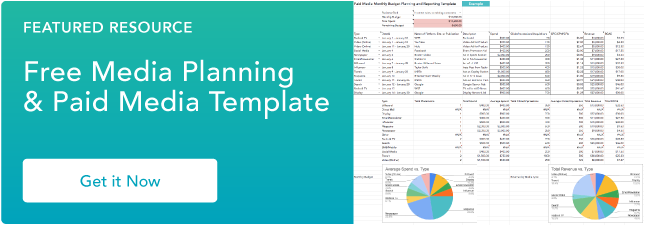
Because of its efficiency and cost-effectiveness, real-time bidding (RTB) has become one of the most popular ways to purchase ad inventory online.
But even for experienced marketers, real-time bidding can be a very confusing concept. So let’s break down what RTB is, how it works, and the pros and cons of using it — all while keeping it jargon-free.
In this post, you’ll learn:
Let’s get started.
What is real-time bidding?
Real-time bidding (RTB) is the process by which companies buy and place ads online through automated auctions. Real-time bidding takes the work out of advertising by making it possible for advertisers to place hundreds and thousands of ads online, often in less than a second, without needing to individually reach out to online publishers.
Real-time bidding is the driving force behind most programmatic advertising campaigns. Programmatic advertising is “the automated process of purchasing and selling online ads.” Real-time bidding allows advertisers to automatically buy ad inventory, place the ads online, and get a certain number of impressions in their programmatic advertising campaigns.
⭐Don’t have time to read the entire post? Listen to our podcast below about real-time bidding and programmatic advertising:
Click here to find more valuable content from the MarTech podcast.
In a traditional media buying process, you have to manually buy ads. Let’s say that you find a magazine that serves your buyer persona. You ask for the media kit, choose the ad dimensions that fit your budget, and then buy the ad for a certain amount of time. Once time runs out, the ad is taken down.
Real-time bidding takes out all of that work. You can get space on that magazine and hundreds of others by letting a Demand-Side Platform (DSP) automatically choose the best publishers and ad spaces, then bid on them for you. You set several certain targeting parameters, such as maximum bid price and target audience. These parameters then determine where your ads are placed.
The publisher accepts your ad only if you place the highest bid. But remember: real-time bidding automatically does all the bidding. You don’t have to take any additional steps.
Still confused? No worries. We break down the concept further below.
How does real-time bidding work?
There are several pieces involved in the real-time bidding process. Let’s take a look at each one of them one-by-one before putting it all together.
- Advertiser: The advertiser is the company or brand that wants to place an ad online.
- Demand-Side Platform (DSP): The Demand-Side Platform is the service advertisers use to launch ad campaigns.
- Publisher: The publisher is the website or online property that wants to sell ad spaces, often referred to as “ad inventory.”
- Supply-Side Platform (SSP): The Supply-Side Platform is the service publishers use to make ad inventory available. SSPs run auctions where ad spaces are instantly purchased by the highest bidder. But this can’t happen unless an ad exchange facilitates the transaction.
- Ad Exchanges: The ad exchange connects companies who want to advertise and publishers who want to sell ad space. Ad exchanges carry out the bidding transaction automatically in real time by connecting both Demand-Side Platforms and Supply-Side Platforms.
- Impressions: Impressions refers to the number of times an ad is seen or scrolled past. In the real-time bidding process, advertisers don’t pay for one individual impression, but rather the cost per thousand impressions (CPM).
Now, let’s put it together. How exactly does real-time bidding work?
On the advertiser side, marketers use DSPs to set up their ad campaign and track its performance. Publishers, on the other hand, use Supply-Side Platforms (SSPs) to list their ad inventory and the price they charge. They then meet in the middle at the ad exchange, the marketplace where the real-time bidding actually takes place.
To determine what ad inventory to bid on, advertisers will set targeting parameters. For instance, a brand may only want to target users who are in a specific region or have visited their website recently.
So, advertisers, or specifically their Demand-Side Platforms, evaluate ad potential in real time and decide whether or not to place a bid and how much to bid.
Remember, advertisers set their bid through the Demand-Side Platform, while publishers’ Supply-Side Platform either accept or reject the bid. The prices are negotiated on a cost per thousand impressions, so the advertiser isn’t paying based on uptime or even dimensions. Instead, they’re paying for the amount of times, in thousands, that their ad is seen.
Let’s go through another example of how it works.
Real-Time Bidding Example
Let’s say Silk is a UK-based beauty brand that just launched a new brow line and is running a campaign. They set up their campaign on a Demand-Side Platform (DSP) and are targeting users who regularly shop for makeup products, are located in the Manchester area, and are between 18 to 30 years of age. The brand also wants its ads to only show on sites related to beauty and lifestyle.
A user visits a publisher’s site. The publisher’s Supply-Side Platform (SSP) sends a bid request to the ad exchange, where Silk’s DSP will be evaluating the value of the impression. The DSP will then determine if the user meets the parameters outlined in the campaign. If so, the DSP will submit a bid.
If Silk has the winning bid, the user will see the ad once the page loads. This process happens thousands of times on different webpages during the length of Silk’s ad campaign.
Silk’s paid ads manager will also be monitoring their ad’s performance on the DSP to see if it’s reaching the desired audience, or if the parameters should be adjusted.
Real-Time Bidding Platforms
There are no RTB platforms because real-time bidding is a method of purchasing impressions, not a channel. However, you can use tools that can help you start the real-time bidding process. These tools help you either purchase ad inventory or place ad inventory for sale through RTB.
Below, we break down some platforms you might use if you’re looking to sell or purchase ad inventory online.
Real-Time Bidding Platforms For Advertisers
As an advertiser, you’ll want to find a Demand-Side Platform that allows you to manage several ad campaigns and set specific targeting parameters — down to the user’s most visited websites and preferred brands. Here are a few options:
- AdRoll: Self-serve Demand-Side Platform that’s a good fit for beginners in the programmatic advertising space.
- mediasmart: Self-serve Demand-Side Platform that provides advanced targeting and segmentation capabilities. Good fit if you’ve set up ad campaigns with other tools, such as Google Ads.
- theTradeDesk: Demand-Side Platform that allows you to place ads on multiple devices, including TV ad rolls, online videos, music streaming devices, mobile apps, and publishers across the web. Good fit if you’re planning to advertise across all of these channels.
Real-Time Bidding Platforms for Publishers
If you have ad inventory to sell, then signing up on a Supply-Side Platform is essential to take advantage of the real-time bidding process. You don’t have to speak with any advertisers, negotiate prices, or do any of the manual work that’s typically associated with account management.
Here are a few channels that will allow you to sell ad inventory through real-time bidding:
- Magnite: Supply-Side Platform for large-scale ad inventory sellers who also want to sell ad space through Private Marketplace (PMP) and Programmatic Guaranteed (PG). Good fit if you’re an experienced ad seller that wants to upgrade to a more capable system.
- Index Exchange: Supply-side marketplace that allows you to get started with ad inventory selling on multiple channels, including display, video, mobile, and native. Good fit if you’d like to start selling ad inventory or if you plan to take advantage of all of the available channels.
You can find more SSPs here.
Still not sure whether you should sell or buy ad space through real-time bidding? We go over the pros and cons below.
Real-Time Bidding Pros
Better Tracking
With RTB, advertisers can monitor their campaigns easily without relying on vendors. No need to reach out to multiple publishers and ask for reports, you can get them yourself on your DSP.
This also gives marketers the agility to pivot quickly if their campaign isn’t performing as expected. For instance, you might find that switching out one keyword for another may boost your campaign’s performance and align better with the audience you want to reach.
Better Targeting
When purchasing ads through RTB, you buy one impression at a time. This means that every time a website visitor or mobile app user visits a publisher’s site, you’re able to assess that person’s particular profile and see if it matches your target audience.
It makes for more accurate targeting as you can ensure your ads are only reaching the right people at the right time.
More Cost-Effective
The precision of the real-time bidding algorithm allows marketers to spend their ad dollars on high-value impressions.
Too often, brands launch marketing campaigns that only reach a portion of their target market, leaving the rest of the budget wasted on users who don’t fit the profile.
In addition, RTB takes much of the manual labor out of the online advertising process, allowing marketers to focus on other efforts.
Real-Time Bidding Cons
Compromised Brand Safety
Where your ad shows up is as important as who sees it. This is because consumers judge brands’ ads based on the surrounding content.
An Ad Colony survey reported that 60% of consumers have a negative perception of brands whose ads appear near inappropriate, hateful, or offensive content. This can be anything from a site that hosts pirated movies to sites promoting hate speech.
Due to the nature of RTB, there is a risk your ad may appear on a site with content you wouldn’t want your brand associated with. However, brands can limit this issue by putting certain keywords and sites on a “deny” list. This protects brands from showing up on webpages or mobile apps that don’t align with their identity.
Potential Ad Fraud
Ad fraud happens when scammers (or any parties with ill intent) try to trick digital ad networks by falsifying impressions and clicks using bots. Obviously, bots aren’t real people — so they aren’t potential buyers you can eventually convert into customers. Because you don’t get to hand-pick publishers through real-time bidding, there’s the very real chance your ad might be seen by bots instead of real people. The rising sophistication of bots can also cause brands to gather inaccurate data on their campaigns.
Some deceitful publishers fabricate impressions to steal from advertisers. One way to combat this is by using a DSP or ad network with fraud detection software.
Real-Time Bidding is the Easiest Way to Increase Brand Awareness
Real-time bidding makes the online advertisement process fast and easy. Marketers can skip the back-and-forth previously associated with ad buying and focus on tracking the results, increasing the ROI from your campaigns and empowering your brand to grow better.
Editor’s note: This post was originally published in March 2021 and has been updated for comprehensiveness.





